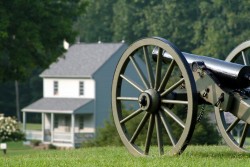Civil War History in Southern West Virginia
March 15, 2022 Find fascinating Civil War history tucked away in the hills of Southern West Virginia. Originally a part of Virginia, West Virginia was actually birthed during the Civil War when it seceded from the Confederacy and declared its independence in 1863. Learn about our notable origin story and the impact our state had during the war by taking a trip to some of our area’s most significant historic sites.
Find fascinating Civil War history tucked away in the hills of Southern West Virginia. Originally a part of Virginia, West Virginia was actually birthed during the Civil War when it seceded from the Confederacy and declared its independence in 1863. Learn about our notable origin story and the impact our state had during the war by taking a trip to some of our area’s most significant historic sites.
Nicholas County
Set on the rim of the Gauley River Canyon, Carnifex Ferry Battlefield State Park is an important Civil War battle site in Southern West Virginia. This 156-acre park memorializes the 1861 Battle of Carnifex Ferry, a conflict resulting in a crucial Union victory that led to the eventual Confederate withdrawal from western Virginia. The park is also a part of the Civil War Discovery Trail, which links more than 300 historical sites in 16 states. Carnifex Ferry is one of the oldest state parks in the United States and is popular for Civil War reenactments. The onsite museum displays artifacts from the Battle of Carnifex Ferry.
Greenbrier County
Explore the imperative struggles that took place across Greenbrier County. On May 23, 1862, a pivotal battle was fought in Lewisburg. Union troops under Colonel George Crook were camped behind the grounds of the present Greenbrier Community College as part of a larger Federal effort to sever railroad communications between Virginia and Tennessee. The town performs The Battle of Lewisburg Living History and Reenactment every year to educate visitors about Civil War history. While in Lewisburg, explore the multitude of history on a self-guided walking tour. You’ll be able to find a Confederate cemetery, a library that was a Confederate hospital and the North House Museum, which has an abundance of interesting Civil War artifacts and documents.
Droop Mountain Battlefield State Park, located north of Lewisburg in Hillsboro in the Greenbrier River Valley, is West Virginia’s first state park and offers a great deal of Civil War information. Droop Mountain is known for its reenactments of the Battle of Droop Mountain, the last major Civil War conflict in West Virginia.
Lastly, visit Organ Cave for a unique experience. Registered as a National Natural Landmarks and listed on the National Register of Historic Places, Organ Cave is one of the largest caverns in the United States and a popular tourist attraction close to Lewisburg in Ronceverte. During the Civil War, Confederate soldiers mined the cave for nitre, which was used to manufacture gunpowder. Today, Organ Cave has the nation’s largest collection of Civil War-era saltpeter hoppers. Interestingly, part of the cave was also used by Confederate forces as a church, and over 1,000 Confederate soldiers hid out in its depths for almost three years.
Fayette County
During the Civil War, Fayette County was strategic for both Union and Confederate efforts. A small battle between Union and Confederate forces occurred in Fayetteville on September 10, 1862. Confederate forces attacked the Union’s troops at Fort Scammon in hopes of gaining control of the Kanawha River Valley. The battle included what is believed to be the “first use of indirect fire” in a military conflict. Confederate forces gained control of Fayetteville and remained in control for one month until the Union was able to retake control of the area. Fayetteville is also close to many other battle sites, including Gauley Bridge, where a covered bridge carrying the James River and Kanawha Turnpike was taken and retaken three times in 1861 and 1862. Among historical sites in Fayette County include the Contentment Historical Complex, the African American Heritage Family-Tree Museum and a Confederate cemetery all located in Ansted.
Mercer County
The first stop on the Civil War Trail in West Virginia is the McNutt House in Princeton. This historical building served as the Union headquarters and a hospital during the Civil War. Mercer County’s Civil War history is also marked with the Battle of Pigeon Roost. This encounter occurred in Princeton on May 17, 1862. Prior to this conflict, Princeton was burned by Confederate soldiers. Ultimately, Confederate troops ambushed Union troops and prevailed. More information about Mercer County Civil War history can be found at the Mercer County War Museum in Princeton.
Are you ready to explore the historic sites and battlefields of Southern West Virginia? Uncover the substantial history of the Civil War on your next trip.

